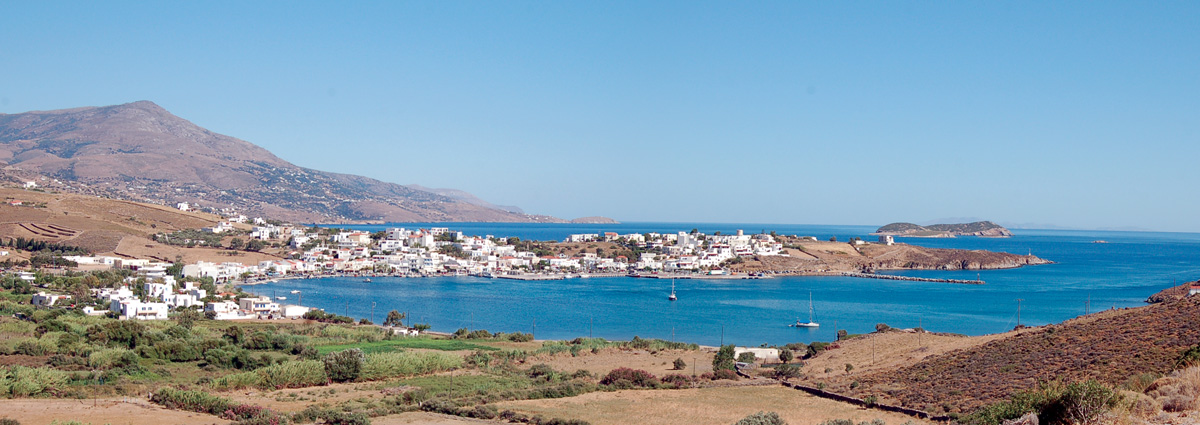
According to mythology, the island was named after Ándro, son of Ánios, who was a son to god Apollo. However, there is another theory, supported by the ancient Diódoros of Sicily, that the island was named after the general Ándro of King of Crete Radámanthy. Ándros was also known in antiquity as Ydroúsa, Lasía, Nonagría and Epagrís, all these names due to its rich vegetation and the many rivers, streams and fountains.
Ándros is continuously inhabited since 4000 BC. Excavations brought to light many types of vases, several tools and chambers / houses from different tribes: Káres, Phoenicians and later Minoans, Pelasgoí and last Íones.
Due to its geographical location, Ándros in antiquity was one of the largest and most important nautical and commercial centres of Greece, connecting the Minoan Crete with the cities of mainland Hellas.
During the Hellenic – Persian Wars, the islanders were on the side of the Persians. Thus, when in 480 BC. the Persians lost the War and withdrew from Greece, the Athenians decided to teach a lesson to Ándros. The “education” was unsuccessful as the walls protecting the city of Ándros proved quite difficult to conquer. Two years later, what the arms did not complete, diplomacy did. Ándros entered the Alliance of Dílos, which was part of the Athenian Principality. The island was conquered by the Spartans during the Peloponnesian War in 411 BC.
In the Byzantine years, Ándros city was among the first to embrace Christianity. As the island was very conveniently placed near the sailing routes to Constantinople, a Customs station was built in Ándros. Further to that, the island grew stronger and richer, building a large fleet.
When the Franks conquered Constantinople in 1204 BC, the dominance of Ándros passed on Venetian hands. In 1537 AD, the Ottomans lead by admiral Hayreddin Barbarossa, conquered Ándros and tried several times in the following years to islamise the inhabitants. Ándros was freed in 1825, during the Helenic Wars of Independence.
There are several interesting museums in the city of Ándros, all of them worth visiting. Also, visit the castle on the beach of the capital city. Another sight is Zagóra, on the plateau with the same name located in western Ándros. According to archaeologists, it is an ancient city from the Geometrical Era.
The island is blessed with incredible sandy beaches, very many in number. Every twist of the coastline includes one more beach. Because the island is windy almost throughout the year, it is better to moor safely wherever you find berth and then drive around the island with a rental car, which …wiggles a lot less with the wind.

Gávrio: Operated as a municipality from 1835 onwards. After the Hellenic Wars of Independence, numbered 900 inhabitants and was used as the main harbour of Ándros. Today, Gávrio has a significant touristic traffic, mainly because 2 of the nicest beaches of the island, the beach of Ágios Pétros and the beach of Xrysí Ámmos (Golden Sand), lie approximately 2 km away.
Kórthi: It was built by the Franks around the 17th century, who named it Kórti and fortified it to defend themselves from the pirates and the Turks (one and the same thing). Today’s name Kórthi is basically the Hellenic version of the foreign “Kórti”, which down the years spread and became official. There is a folklore museum in the village.
Kástro: The capital Ándros or Kástro according to the locals, was built in the 13th century during the Frankish Rule. The Franks remained on the island up until 1670, when Crete, their last colony, fell to the Turks and then they withdrew from everywhere in the Aegean. Two years later the city of Kástro was destroyed by pirates and was eventually abandoned up until 1750, when its citizens started returning.
Kástro is a magnificent castle-city, built on the cape of Kástro and all of its old houses are within the walls of the city. A walk in its alleys will explain why travelers today call the island “aristocratic”.
Batsí: A modern settlement built around a beautiful bay and a sandy beach. It attracts many tourists, both by sea and land. Visit the church of Ágios Fílippos, on its nameday there is a celebration in Batsí.



